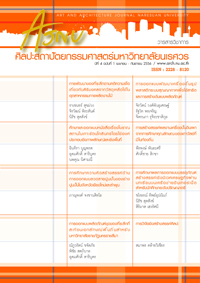การออกแบบพัฒนาเครื่องขึ้นรูปพลาสติกระบบสุญญากาศ เพื่อใช้สาธิตและการสร้างต้นแบบผลิตภัณฑ์
Main Article Content
บทคัดย่อ
งานวิจัยนี้ เป็นงานที่เกิดขึ้นมาจากการพบปัญหาของเครื่องขึ้นรูปแผ่นพลาสติกของทางภาควิชาออกแบบผลิตภัณฑ์ ที่ใช้ได้กับแผ่นพลาสติกที่มีขนาดใหญ่ แต่จะมีปัญหากับนักศึกษาที่ต้องการขึ้นรูปกับชิ้นงานขนาดเล็ก ทำให้เกิดความสิ้นเปลืองใน เรื่องวัสดุรวมถึงพลังงานไฟฟ้าที่ใช้ ด้วยเหตุผลดังกล่าวทำให้เกิดงานวิจัยนี้ขึ้นมาเพื่อแก้ปัญหา โดยมีเป้าหมายของการทำงาน คือ เพื่อศึกษาและออกแบบเครื่องขึ้นรูปแผ่นพลาสติกระบบสุญญากาศที่เหมาะสมกับการสร้างต้นแบบผลิตภัณฑ์ โดยสามารถ ปรับขนาดวัสดุให้เล็กลงตามขนาดของชิ้นงานได้รวมทั้งสร้างความสะดวกต่อการใช้งานและการเคลื่อนย้ายได้โดยลำพัง อีกทั้งใช้ ระบบการควบคุมกึ่งอัตโนมัติเพื่อการเรียนรู้รวมทั้งทำการทดสอบเพื่อหาประสิทธิภาพในการขึ้นรูปของแผ่นพลาสติกในชนิดต่าง ๆ ในเรื่องขนาดและความหนาที่ต่างกัน ผลการวิจัยพบว่า เครื่องขึ้นรูปแผ่นพลาสติกที่สร้างขึ้น สามารถตอบสนองต่อการใช้ งานแบบกึ่งอัตโนมัติเพื่อการเรียนรู้ ที่มีการใช้งานที่สะดวกสบายขึ้น โดยผ่านการยอมรับจากผู้ทรงคุณวุฒิที่เกี่ยวข้องกับการ ออกแบบทางผลิตภัณฑ์ 3 ท่านรับรองผล ผลการออกแบบสามารถที่จะนำแผ่นพลาสติกมาใช้กับเครื่องนี้ได้ 8 ขนาด รวมทั้งผ่าน การทดสอบการขึ้นรูปแผ่นพลาสติกกับพิมพ์แม่แบบรูปทรงเหลี่ยม ที่เพิ่มชั้นระดับความสูงขึ้นทีละ 4.5 ซม. และเครื่องสามารถ รองรับความสูงได้ถึง 35 ซม. โดยทำการทดสอบความร้อนที่ใช้แท่งฮีตเตอร์ที่ 2,000 วัตต์ กับแผ่นพลาสติกขนาดเล็กที่ กว้าง x ยาว เท่ากับ 22 x 22 ซม. และฮีตเตอร์ความร้อนที่ 4,000 วัตต์ กับแผ่นพลาสติกขนาดกลาง 32 x 32 ซม. รวมทั้งฮีตเตอร์ ความร้อนที่ 6,000 วัตต์ กับแผ่นพลาสติกขนาดใหญ่ 32 x 41 ซม. ที่เป็นตัวแทน โดยการขึ้นรูปได้นำพลาสติกแผ่นพีวีซี ขนาด ความหนาที่ 0.6 , 1.0 , 2.0 และ 3.0 มม. และแผ่นพลาสติก เอบีเอส ความหนาที่ 1.0 , 2.0 และ 3.0 มม. รวมทั้งพลาสติก อะคริลิค ที่ความหนา 1.0, 2.0 และ 3.0 มม. มาทำการทดสอบ ผลการทดสอบได้บันทึกค่าการขึ้นรูปของพลาสติกทั้งหมดไว้ โดยแผ่นพลาสติกที่มีประสิทธิภาพในการขึ้นรูปสูงสุด ที่ความร้อนฮีตเตอร์ 2,000 วัตต์ ใช้อุณหภูมิที่ 60 ๐c ได้พลาสติกแผ่นพีวีซี กับความหนาที่ 0.6 มม. สามารถขึ้นรูปชิ้นงานได้ กว้าง x ยาว x สูง ที่ 7.5 x 9 x 9 ซม. และที่ 4,000 วัตต์ ใช้อุณหภูมิที่ 46 ๐c ได้พลาสติกพีวีซี ที่ความหนา 1.0 มม. ได้ชิ้นงานขนาด 17 x 17.5 x 9 ซม. รวมทั้งที่ 6,000 วัตต์ ใช้อุณหภูมิที่ 47 ๐c ได้ พลาสติกพีวีซี ที่ความหนา 1.0 มม. โดยได้ชิ้นงานขนาด 17 x 27.5 x 18 ซม. ส่วนในภาพรวมกับพลาสติกที่หนา 3 มม. ทั้ง 3 ชนิด ผลการทดสอบไม่สามารถขึ้นรูปได้เต็มแบบแม่พิมพ์ แต่ถ้าจะนำมาใช้งานจริงควรมีอุปกรณ์ช่วยในการกดรอบพิมพ์ซึ่งทำต้องในช่วงของการดูดขึ้นรูปด้วย สรุปผลการวิจัย เครื่องต้นแบบที่สร้างนี้ สามารถนำมาใช้ในภาควิชาออกแบบผลิตภัณฑ์ที่จะช่วย ให้นักศึกษาที่เรียนด้านการออกแบบสามารถทำการออกแบบให้เกิดชิ้นงานใหม่ ๆ ขึ้น ซึ่งจะเป็นประโยชน์ต่อการสร้างงานในการ พัฒนาการศึกษาต่อไป
The design and development of the vacuum forming model products one building and for the demonstration
This research derived from a problem found through a process of vacuum forming with oversize plastic sheet, where students from the Department of Industrial Design tended to utilize a smaller piece instead of a size assigned to the existing large production machine. This practice then leads to material waste and inefficient use of energy of these repeated small productions. Thus, these continuous misuses have generated inquiries for this research with objectives to- study and design a manageable semi-automated system of a vacuum machine that also accounted to portability, easy accessibility to adjust and compensate each design to any particular needs intended for the type of plastic use, the model’s size and volume, as well as thickness variation of the plastic. As a result, the designed vacuum forming machine pertain the semiautomated system and met the intended objectives that were acceptable by three specialists in industrial design. The new machine was able to accommodate up to 8 different sizes of plastic sheet, which now supported the rectangular shape with adjustable step increment of 4.5 cm. and with maximum height of 35cm. It was also tested with an installment of a heating rod at 2,000 watts with the use of small plastic sheet (22x22cm.), then increased to 4,000 watts with a medium sheet size (32x32cm.), and finally with a heating rod of 6,000 watts with large sheet of plastic (32x41cm.); to which apply with the selective thickness of PVC of 0.6, 1.0, 2.0, and 3.0 mm. (increased with sheet size and watts), with ABS sheet of 1.0, 2.0, and 3.0 mm, as well as with acrylic of 1.0, 2.0, and 3.0mm. thickness. The three tests yielded the highest quality in the following combinations: at 2,000 watts at temperature of 60 ๐c degrees Celsius with PVC 0.6 mm., which resulted with model area of 7.5W x9L x9H cm., at 4,000 watts at temperature of 46 ๐c with PVC 1.0 mm., which resulted with model area of 17W x17.5L x 9H cm., and at 6,000 watts at temperature of 47 ๐c with PVC 1.0 mm., which resulted with model area of 17W x27.5L x18H cm. As for an overall result, all three plastictypes with thickness of 3.0mm were unable to form into the shape of a mould, but would required an additional press to lock plastic the piece in place during the vacuuming process. The final design of this new vacuum-forming machine is valid and can be use within the Department of Industrial Design to assist students in producing new design idea, which certainly will also continue to benefit their educational development processes.


